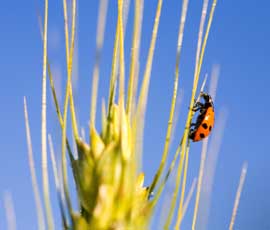Wildlife benefits need better on-farm measurement

On-farm wildlife gains need assessing more accurately than the crude measures of success that underpin current environmental policies, was the message from speakers at CropWorld. But payment by results would be a step too far.
The RSPB-managed Hope Farm in East Anglia has shown a threefold increase in bird numbers in 11 years, returning them to pre-1970 levels, RSPB senior agricultural advisor Richard Winspear told the conference in London. But is that a true measure of success?
That result was achieved by removing an average 6% of arable land from production and implementing RSPB “smart solutions”, ideally including 2% of arable land managed as a seed-rich source of food, or 5% of over-wintered stubbles left unsprayed and uncultivated until at least mid-Febrary, plus 1% as flower-rich habitats. Twenty nesting plots per 100ha of arable crops could help other species. “That is completely in keeping with sustainable intensification,” noted Mr Winspear.
But Philip Merricks, who owns and farms the 1200ha Elmley estate and nature reserve on the north Kent and Romney marshes, visited by 20,000 visitors a year, suggested environmental success should be measured more precisely.
“Chick productivity is what counts, not how many adult birds have been attracted to a site by the very good habitat management. Ecological traps or population sinks are likely to be created when the factors that attract birds to a site are divorced from those that ensure reproductive success.
“Put another way, you can spend a lot of money on a maternity ward, but if mothers-to-be are left in the car park, it will not be a success.”
Lapwing chick survival needs to be 0.7 chicks per adult to sustain a population, he noted. At Elmley in 2010 meticulous habitat management, integrated with commercially viable farming, saw 1.33 chicks survive, nearly twice as many as needed to maintain the population. Hopefully, that means some will move to repopulate other sites. That is just as well. Another nature reserve achieved only 0.28 chicks, and sites adjacent to Elmley managed just 0.11 and no chicks per adult.
Focus on outcomes, not ticking scheme boxes, Mr Merrick urged. “Paying for results would be iniquitous, requiring measurements and audits, but we do need to get outcomes into the agri-environment package, and it isn’t in there at the moment.”
Simply carrying a camcorder in the Land-Rover would allow evidence to be collected of wildlife benefits stemming from specific environmental measures. “It could be a form of self-verification for farmers.”
Fraser Hugill, CFE campaign co-ordinator and Yorks farmer, agreed. Shifting farmer mind-sets is the most important measure of environmental policy success, he said. “Payment by results might turn famers off, particularly if they were delayed while measurements are made.”
Set-aside benefits need to be recaptured from a relatively small area of well-located and positively managed land, he urged. Farmer-led local liaison groups can help, engaging with special interest bodies. Beacon farms also provide something for neighbours to aspire to.
